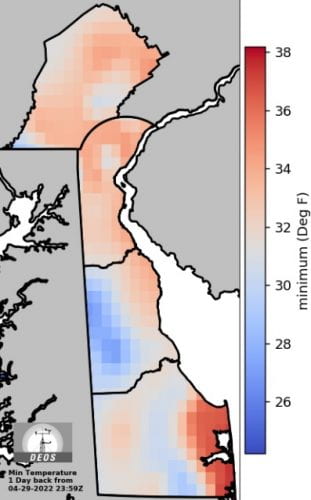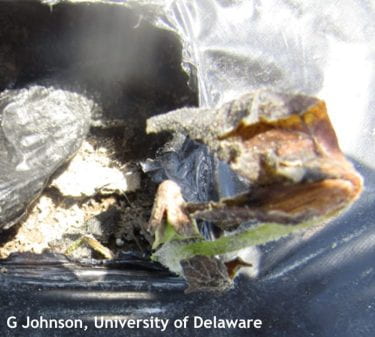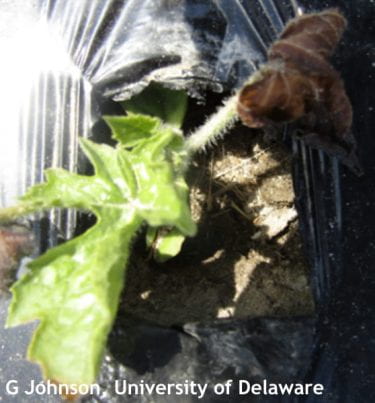Gordon Johnson, Extension Vegetable & Fruit Specialist; gcjohn@udel.edu
The frost we had last week should remind growers that as you try to get a jump on the growing season, cold weather effects need to be considered. Over the years, many of our early plantings of summer vegetables have suffered because of cold damage and inadequate provisions to protect plants.
Earliest plantings of watermelons, summer squash, and tomatoes began last month. First transplanting of crops such as cantaloupes, peppers and eggplant will begin in early May. One of the characteristics that all of these crops have in common is that they are warm season vegetables that are sensitive to cold temperatures, both in the root zone and above ground.
Transplanted warm season vegetables vary in their ability to tolerate adverse weather after being set out. Tomatoes will stop growth but will grow out without much damage once warm weather returns. Summer squash also handles adverse conditions fairly well. Watermelons will hold if they have been hardened off properly. Cantaloupes can be permanently stunted if exposed to excessively harsh early conditions. Peppers and eggplants will not put on any root growth until temperatures are warm enough.
Rate of root growth or regeneration is temperature dependent with cool season vegetables such as cabbage or lettuce being able to produce new roots at much lower temperatures than warm season vegetables such as eggplant or watermelon. In soils that are below critical temperatures (60-65°F for watermelon and cantaloupes for example) roots do not grow into the soil bed and transplants will be subject to desiccation losses as soils dry around the root ball. The smaller the root ball (the smaller the tray cell size), the more quickly desiccation and plant loss can occur.
For Solanaceous crops tolerance to cold soil is as follows Tomatoes > Peppers > Eggplant. For cucurbits tolerance to cold soils is in this order Cucumber > Summer Squash > Watermelon > Muskmelon.
All of these vegetables are susceptible to frost damage and will be killed by a late freeze. Many areas on Delmarva had temperatures as low as 25 °F on April 29.

Minimum temperatures in Delaware on April 29, 2022. (Weather data from DEOS)
In years with cold, cloudy, windy weather after transplanting, we have had large losses of transplants in the field. In many fields considerable hand labor was used to replace dying plants and in some cases whole fields were replanted. It is critical to have warm soil conditions after transplanting to allow roots to grow out into the bed quickly. What happens in cold, cloudy conditions is that plants shut down physiologically. Little root growth occurs and the existing roots on the transplant do not function well. If there is any wind, plants lose more water than they can take up and they die due to desiccation. This is accelerated when the sun does come out – the first sunny day after an extended cold, cloudy period is when you will see the most wilting of weakened transplants.
Later on in the growth cycle, cold weather during flowering can lead to problems with pollination and fruit formation resulting in reduced fruit set and malformed fruits.

Watermelon plant with dead growing point due to freezing weather. Buds at the cotyledon are intact. However, without any leaves, the plant may not have enough energy to regrow.

Watermelon plant with live growing point and only one leaf damaged. This plant will regrow.

Watermelon plant with dead leaves and damaged growing point but with live buds at the leaf axil and cotyledons. This plant is marginal on the potential for regrowth

Watermelon plant with minimal damage will continue to grow.
